- INTRODUCTION
- MEASURE CAR ONE
- TEST SERIES 1-1
- TEST SERIES 1-2
- CONCLUSIONS, FORMULAE & DIAGRAM
- MEASURE CAR TWO
- TEST SERIES 2-1
- TEST SERIES 2-2
- TEST SERIES 2-3
- Test of Viscosity
- Isopropyl alcohol or IPA
- Acetone
- X66 is both a power and cleaning additive
- How to produce special glycol - SG - for the fuel additive AG
- Here is the older material
This, I have waited a long time for. A car equipped with an accurate measurement of fuel consumption, carried out to test different types of fuels.
How many times have you heard rumors about this and that that will lead to lower fuel consumption? Different kind of magic formula that you mix with the gasoline or various devices of all kinds, invented by enthusiastic individuals who are often derived ”from over there” and having there heads in the clouds rather than steadily over the trunk.
Must say that I admire people who ignore all conventions and goes its own way - perhaps because I myself am a bit in that direction? One problem is that these desires are not too often lacked the necessary training and therefore easily proceed to invent new laws of nature that is also tailored to provide support for their work. Here, I think they exaggerate there ego in an embarrassing way - you have to be humble. Humans have for centuries (or at least decades) through hard work, exchange experiences, through experiments, the consistent failure - eventually got clarity in how it relates. - Respect!
But how does one really know? It can be difficult to read a fuel gauge. How much of the old fuel was left in the gas tank when I started? Or, how full was the tank? Has anyone given any adequate ground to measurement if you do not top fill the tank? But but... is the improving or deteriorating real enough although this measurement method works also. Otherwise, it probably works just as well with a trip computer.
In a prepared five or ten liters tank in the cockpit related to the vehicle engine we can make direct measurements. You get an immediate reply as to whether this or that entails a consumption gain. This removes some uncertainties that may vary over time (as it takes to empty a full tank of fuel). Eg weather conditions and driving behavior that can vary depending on when driving in city traffic or on the road. If you have only a few liters to measure you can be eg use a specific type of driving and make different comparisons, all on the same day.
This applies to not run out of the extra tank, for example, driving on a highway. In general, such a facility requires that you may pay extra attention and adapt your driving style.
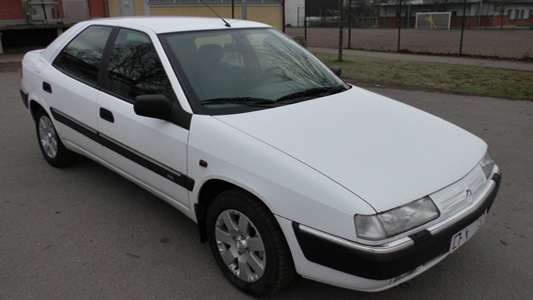

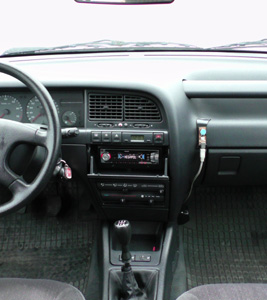
My first car for this kind of experiment was a gasoline-powered car of model year 1995. A two-liter water-cooled straight four with eight valves and manual transmission. No AC or turbo, furthermore, equipped with electronic fuel injection MPFI of conventional type. Apart from the gas-hydraulic system of suspension, including the brake and wheel steering, so I also have the system of water separating from the crankcase (you can read about this above). It lacks air hose from the grill to the air filter; instead there is a 12V computer fan right next to the air filter.
In addition, there is a pulse extension circuit of the type IPE-GS, which allows me to use both gasoline and E85 in what proportions any time and without any derogating from the lambda one. With the help of the IPE-GS, I can also run on pure ethanol or similar alcoholics without the gasoline additive, which I probably will devote myself to do here.
IPE-GS can be equated with the function LTFT (long-term fuel trim) that newer cars are equipped with. In fact, it is only limitations in the software that prevents many cars to be able to adjust for various low-energy fuels and LTFT manages this seemingly automatic - while my IPE-constructions generally are intended for manual adjustment.
I doubt that you would like to perform this kind of samples on a newer car, but when my car is quite old and worn so I think it fits perfectly with this type of experiment. Eventually I will restore the car to its normal state but first a few things must be sorted out...
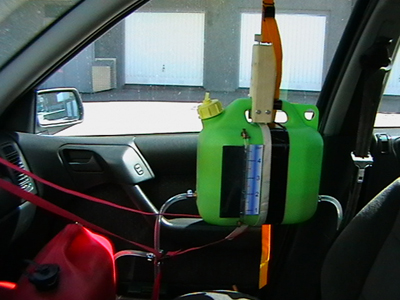
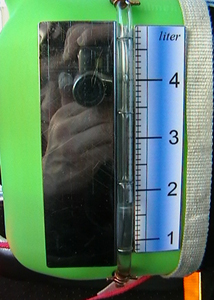

It proved possible to connect the hose from the fuel pump to the engine and return so that you can use a second tank in the car. I thought it would be pretty easy to do this but when the fuel pump is located in the fuel tank and thus can absorb the fuel directly had I to lift up the pump and build a special connection to the suction side. The pressure side demanded nothing extra and remained untouched. The fuel capacity was found to be 2.5 liters per minute - a considerable flow! The pressure is about 2.5 bars and decreases slightly at idle. The green tank/plastic container I have built on, have a level glass. It is easiest to make a mark with a marker pen before and after a rout and then taking the difference - at home or on site. The container is balanced and hangs from the roof coupe. Then the car can tilt without any reading error occurs.
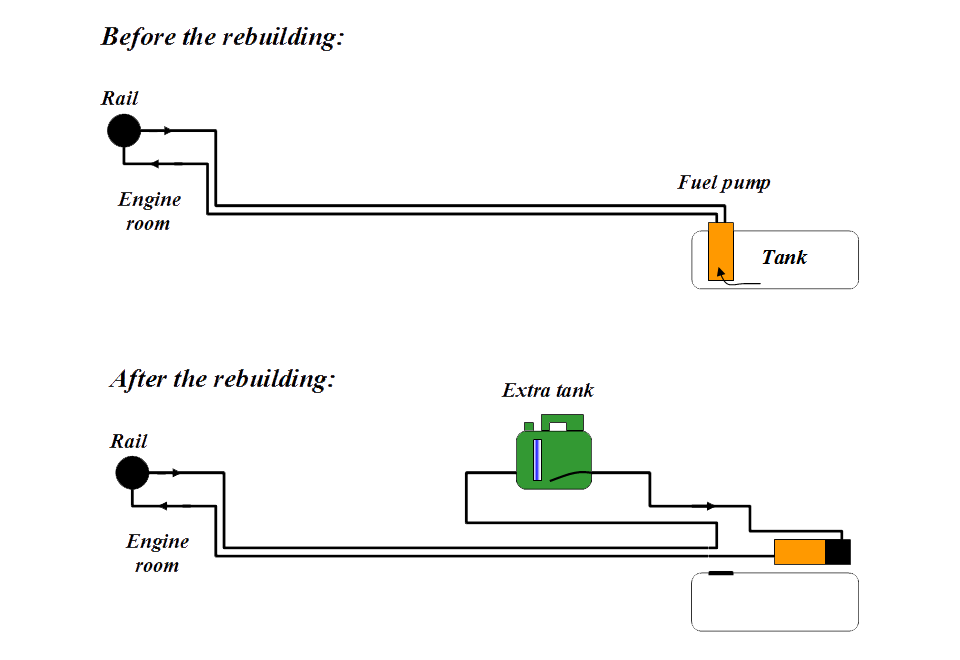
Then you should strive for high reliability shall the testing be performed several times. The result should be the average of two or more routs. My experience is that if you drive a distance on a road that may serve as a test and then turns back, which gives two samples. Mostly the fuel consumption differs. That's because the road is leaning but it can also be due to the wind? So either it is uphill, downhill, tailwind or headwind - but the average will equalize this. It is good if you make a reference sample. In this case, unleaded 95 octane gasoline (Swedish type of standard gas that content 5 % ethanol) remain as a reference fuel, since this fuel appeared to be uniform. All year round I thought, but somewhere I became aware that even E5 (95 RON) change over the seasons?
Common to all tests:
Normal driving, no hard braking or acceleration.
No load in/on-loaded and that there is only one person (the driver) in the car.
The lambda is always one or near one.
The outdoor temperature is in Celsius. 20 Celsius is 68 Fahrenheit or 293 Kelvin.
15 Celsius is 59 Fahrenheit or 288 Kelvin.
In Sweden we normally use liters per mils (10 km). 1 liter per mil is 23.5 miles per gallon (US).
| No. | Date | Fuel | Ingredient | Driving- condition |
E.c. (µS/cm) | Temp. outdoor |
Samples | Test results | Average consumption |
Other / remarks |
| 1 | 2010-06-03 | E84 | - | highroad/sunny |
0.5 | 17 C | 2 | 25.6 ; 27.0 |
26.1 mpg | Common E85. Motala - Nydalen
return. |
| 2 | 2010-06-04 | E87 | 7% water (dest.) | highroad/sunny |
0.6 / 0.9 | 20 C | 4 | 24.0 ; 26.1 & 23.3 ; 26.1 |
24.8 mpg | 0.127 gal water mixed with 2.114
gal E85. The same route: the consumption rose a little bit. |
| 3 | 2010-06-05 | E5 | - | highroad/sunny |
- | 22 C | 2 | 32.2 ; 34.1 |
33.1 mpg | Common U95. Route: Motala
- Nydalen return. |
| 4 | 2010-06-05 | E5 | Acetone | highroad/sunny |
- | 22 C | 2 | 34.1 ; 37.9 |
35.6 mpg |
Acetone add. according to the formula:
A = E5 x 0.0023 in volume terms! Motala - Nydalen return. |
| 5 | 2010-06-05 | E5 | Acetone | highroad/sunny |
- | 22 C | 2 | 37.3 ; 38.6 |
37.9 mpg |
This was a fairly straight roads with maximum
speed limit of 80 km/h (Motala - Vadstena return). |
| 6 | 2010-06-05 | E5 | Acetone | highroad/sunny |
- | 21 C | 2 | 34.1 ; 36.8 |
35.1 mpg |
Repetition of sample no. 4 (Motala - Nydalen). |
| 7 | 2010-06-05 | E5 | Acetone | highroad/sunny |
- | 20 C | 1 | 30.2 |
30.2 mpg | Had to get rid of the old fuel so I
doubled the amount of acetone, just to get a hint. |
| 8 | 2010-06-05 | E5 | (small traces of acetone) | highroad/sunny |
- | 18 C | 2 | 34.1 ; 34.1 |
34.1 mpg | Motala - Nydalen again. Fuel
consumption rose slightly after the acetone was removed. |
| 9 | 2010-06-06 | E5 | - | highroad/sunny |
- | 19 C | 2 | 35.6 ; 37.9 |
36.8 mpg | The route Motala - Vadstena return,
without acetone. |
For this test series, one can draw some interesting conclusions. Apparently you can mix 7% water in E85 without any separation occurs.
I used distilled water and of course it is more expensive than ordinary tap water. I must admit that it felt a bit odd to pour in half a liter of water in my newly bought E85 (8 liters). The disadvantage of water in E85 should well be that the danger of increased corrosion of the fuel components such as pipes and injectors, etc. The conclusion is that if a reducing of the fuel is done by water, then appears this seven per cent also to increase the fuel consumption by five per cent (it was a bit more petrol in the sample with water). The profits are plus minus zero and the efficiency will not rise. After this test, it seems that E85 plus seven per cent of water as a less high-grade fuel than E85 without water.
Another conclusion is that consumption difference with the E85 vs. E5 is 27% - in quantity seen. My car, therefore, consumes 27% more fuel when I run on E85 than when I run the E5 (which is the car's standard fuel). Put it in relation to the pulse duration is 40% larger! The answer for why the consumption not is 40% larger, is due to the fact that the engine develops more power. The power increase reduced the fuel consumption.
In comparison with the Mythbusters, so had I a reduction in fuel consumption with acetone! Subsequent measurements with more accurate methods have also shown that acetone provides a smaller gain for the consumption than this result shows. The profit is so small that it hardly can be measured - perhaps it is so that it is better on highways, as this show about 6%? The question remains open until further notice. Small doses of acetone in gasoline and glycol in ethanol - apart from a negligible effect on fuel consumption - have the ability to reduce the need for fuel, ie opening time of fuel injectors.
| No. | Date | Fuel | Ingredient | Driver- condition |
E.c. (µS/cm) | Temp. outdoor |
Samples | Test results | Average consumption |
Other / remarks |
| 10 | 2010-06-06 | E84 | Acetone | highroad/sunny |
0.2 | 22 C | 2 | 27.4 ; 28.0 |
27.7 mpg |
E85 laced with acetone according to the formula: A = E85 x 0.0023. Motala - Nydalen return. |
| 11 | 2010-06-07 | E85 | Acetone | highroad/rain |
0.4 | 13 C | 2 | 28.3 ; 23.1 |
25.3 mpg | E85 laced with acetone according to the formula: A = E85 x 0.0023. Motala - Vadstena return. |
| 12 | 2010-06-07 | E87 | Acetone | highroad/cloudy |
0.5 | 11 C | 2 | 24.0 ; 27.0 |
25.3 mpg | E85 laced with acetone according to the formula: A = E85 x 0.0023. Motala - Nydalen return. |
These attempts (10-12), did I not know that acetone shall be dosed with regard to gasoline content of E85. Why the sample 10 indicates that low consumption is somewhat unusual.
| No. | Date | Fuel | Ingredient | Driver- condition |
E.c. (µS/cm) | Temp. outdoor |
Samples | Test results | Average consumption |
Other / remarks |
| 13 | 2010-06-08 | E87 | Toluene | highroad/sun/rain |
0.6 | 15 C | 2 | 27.4 ; 27.4 |
27.4 mpg |
E85 laced with toluene according to the formula: A = E85 x 0.0023. Motala - Vadstena return. |
| 14 | 2010-06-09 | E86 | Toluene | highroad/cloudy |
0.6 | 18 C | 2 | 24.0 ; 24.8 |
24.2 mpg | E85 laced with toluene according to the formula: A = E85 x 0.0023. Motala - Nydalen return. |
Toluene (methyl benzene) is closely related to benzene - a cyclic/aromatic hydrocarbon. It is used in adhesives and in the manufacture of TNT. Toluene is a typical petroleum products and the largest component of gasoline (10-15%). Therefore it must be in sufficient quantities even in the E85. Toluene in small doses has no effect on fuel consumption. For sample 13 began the dose of the previously added acetone get in the right concentration. We therefore need a very small amount of acetone for E85 which is quite remarkable.
| No. | Date | Fuel | Ingredient | Driver- condition |
E.c. (µS/cm) | Temp. outdoor |
Samples | Test results | Average consumption |
Other / remarks |
| 15 | 2010-06-09 | E87 | Acetone | highroad/drizzle |
0.4 | 18 C | 2 | 28.3 ; 25.6 |
26.7 mpg |
E85 laced with acetone according to the formula: A = E85 x 0.00035. Motala - Vadstena T&R. |
The sample 15 apparently confirmed that acetone in E85 has an affect on the fuel consumption: Acetone = 0.00035 x E85 (0.00035 is the result of 0.15 x 0.0023).
Subsequent samples were performed with glycol. Glycol has been shown to impact on E85 in a favorable way. The fuel consumption does not change but the fuel injector's opening time can be reduced, also the will to draw increases. For a car equipped with a trip computer, such a reduction of the car's timing indicates that it saves fuel, but this is not the case. The reduction of the consumption is not synonymous with the fuel-spreader opening time, when the fuel composition is changing in this way. Glycol in the E85 also increases its conductivity.
| No. | Date | Fuel | Ingredient | Driver- condition |
E.c. (µS/cm) | Temp. outdoor |
Samples | Test results | Average consumption |
Other / remarks |
| 16 | 2010-06-10 | E88 | Acetone + Glycol | highroad/cloudy |
30 |
18 C | 2 | 26.7 ; 26.7 |
26.7 mpg |
E85 laced with Acetone = E85 x 0.00035 and
Glycol = E85 x 0.005. Motala - Vadstena return. |
I have now decided to run the measurement distance in urban environment, mixed with highroad driving (Citroen Xantia). My view is that it becomes more accurate figures if the car has to work over a wider range with several hills, starting and stopping. I'm running now with Teflon in the engine oil and have higher pressure in the tires. The spark plugs are little older than average.
- In the samples should I also assign the prevailing atmospheric pressure in mill bars.
- The ring (tire) pressure should be controlled so that it always remains constant.
- Always running late at night to avoid traffic congestion and obstruction.
- The test section is selected in order to minimize traffic.
- Traffic light stop will be offset by running the car idling at the end of each test - in which all time will be evened out. Driving time is always 29 minutes and 30 seconds.
- The speed limits on the roads will be followed wherever possible.
- Only one test for each fuel.
Motala (the distance is 12.8 miles):

MEASUREMENTS RESULTS:
Common to all tests:
Normal driving, no hard braking or acceleration.
No load in/on-loaded and that there is only one person (the driver) in the car.
The lambda is always one or near one.
The outdoor temperature is in Celsius. 20 Celsius is 68 Fahrenheit or 293 Kelvin.
15 Celsius is 59 Fahrenheit or 288 Kelvin.
In Sweden we normally use liters per mils (10 km). 1 liter per mil is 23.5 miles per gallon (US).
| No. | Date | Fuel | Ingredient | Driver- condition |
E.c. (µS/cm) | Temp. outdoor |
Added pulse | Consumption | Gain | Other / remarks |
| 18 | 2010-08-02 | E5 (95RON) |
- | partly cloudy / 1010 |
- | 17 C | 0% | 29.4 mpg | 0% | Common 95 RON (E5)
which is the car's standard fuel. IPE-GS was unplugged - no pulse digression. |
| 19 | 2010-08-03 | V-POWER |
- | clear / 1000 |
- | 16 C | -8% | 30.5 mpg | +3.8% | Shells V-power. IPE-GS
unplugged but indicate more energy-rich fuel then E5. |
| 20 | 2010-08-04 | E5 |
A9g+ | party cloudy / 1000 |
- | 17 C | -8% | 30.5 mpg | +3.8% | E5 with A9g+ (+ = the glycol
is laced with hexamine). IPE-GS unplugged but indicate more energy-rich fuel then pure E5. |
| 21 | 2010-08-04 | E5 & E85 |
A9g+ & G14a+ | cloudy / 1000 |
3 | 16 C | +2.7% | 27.0 mpg | -8.8% | 50% E5 & 50% E85(St1).
IPE-GS plugged in. |
| 22 | 2010-08-04 | E5 & E85 |
A9g+ & G14a+ | clear / 1000 |
5 | 15 C | +7.5% | 25.6 mpg | -15% | 33% E5 & 66% E85(St1).
IPE-GS plugged in. |
| 23 | 2010-08-08 | E88 |
- | drizzle / 1000 |
0.3 | 18 C | +33.3% | 23.3 mpg | -26% | Pure E85 (without any
additives by me) bought in OKQ8. IPE-GS plugged in. |
| 24 | 2010-08-09 | E45 |
- | cloudy / 1000 |
- | 16 C | +11.8% | 27.0 mpg | -8.8% | Equal parts E5 & E85(OKQ8).
Pure fuels - no additives! IPE-GS plugged in. |
| 25 | 2010-08-09 | E45 |
G3a+ | cloudy / 1000 |
4 | 16 C | +2.7% | 27.0 mpg | -8.8% | Equal parts E5 & E85(OKQ8)
- identical to 21 besides G3a+ IPE-GS unplugged. |
| 26 | 2010-08-18 | E88 |
- | clear / 1015 |
0.4 | 18 C | +33.3% | 23.8 mpg | -24% | Pure E85 (without any
additives by me) bought in OKQ8. IPE-GS plugged in. |
| 27 | 2010-08-22 | E88 |
G15a+ | clear / 1000 |
40 | 16 C | +20.4% | 23.3 mpg | -26% | E85 with the special
additive G15a+ IPE-GS plugged in. |
In this new series of tests we need to acquaint ourselves with various additives - if we do not already know them? Facts about the additives and what they contain are only available for a few of them*. A9g+ is an additive specifically designed for unleaded 95 octane gasoline, because this is a type of fuel that containing ethanol and therefore should it be glycol in the addition - not only acetone.
G3a+ is a new additive which is carefully designed in order to be able to run 50/50, ie equal parts petrol/E85. The point is that you do not need to take any action with the car, but still enjoy the benefits of ethanol in terms of price and environmental emissions. G3a+ does not appear to reduce the fuel consumption in the least, but it reduces the need for an extra injector opening time pretty sharp! I can guarantee that there is a difference between driving with G3a+ than without. With G3a+ runs the car, as if it was normal petrol - it is certainly my view.
Some interesting aspects should be highlighted. In the sample with V-POWER, I could see that my IPE-GS unit indicated an more energy-rich fuel, because the engine run fat, without any extra pulse/opening time were added. This is not true, because the ECU could reduce the opening time. But that means that the engine needs less fuel (at idle) to achieve normal operating status. Furthermore, it should lead to the engine uses less gasoline and it was exactly what happened - the car consumed less with V-POWER than with regular unleaded 95 (which is the car's standard fuel). Further show sample 20 that it works just as good to add A9g into E5 and in performance compare with V-POWER. So with A9g can even you feel the horses running at the beach :) (Should be added that) these reductions in fuel consumption are quite moderate and are adjacent to the error tolerances. Only two oz differed between the sample 18 and 20!
In august 2010 commanded not to some sensational atmospheric pressure variations, either, for it was for the most part low-pressure and during these cycles was the weather situation in the Motala area, relatively stable.
Additives with a plus sign are using G+, instead of ordinary ethylene glycol. G+ has been shown to reduce the opening time further. G15a+ is a somewhat extreme variant, which not turned out to be better. G15a+ does not contain 15 parts glycol and 1 part acetone! The ratio 15/1 however, is quite a sensible combination. G14a is the oldest additive which were replaced by G16a and later G19a, but now is G14a back again! It has been shown that the best combination of these three variants is G14a.
* = Nowadays is G3a and A9g obsolete additives and thus replaced with UGA and A40/A8g.
My experiments have shown that a small dose of acetone in gasoline provides an immediate efficiency for gasoline engines. The effect increases and the fuel consumption decreases. The efficiency is of the same grade for cars that run on E85 - if the dosage of acetone is done after the gasoline content.
My discoveries is originally originated from Internet, there I found a chart which later was translated to SI-units (below). A Swedish source about glycol whose task is to work as an ignition improver in ED95.
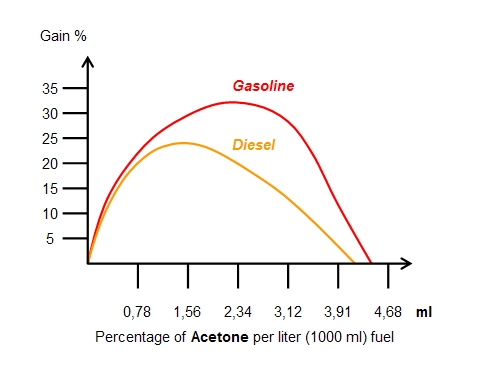
The graph shows an average of three cars that were included in this evaluation, but only one diesel car. The improvement probably relates to the increased mileage per gallon and can apparently exceed up to 35% - it sounds promising but is almost certainly a misunderstanding. Here have probably someone downloaded the information from a trip computer? A trip computer measures the opening time of fuel injectors and it decline pretty much with acetone, according to the dosage above. Based for my own studies is the actual fuel consumption gain only 4-6% - not 35%!
The x-axis is initially calibrated in ounces (oz) 1, 2, 3, 4, 5 and 6 - in which one ounce is 29.57 ml in units per 10 gallons - where a gal is 3.758 liters. If you pour in too much acetone, the curve crosses the zero line and the car draws more fuel than before - because acetone produces less energy than gasoline does and also decreases the octane number. In addition, the fuel components will not function well with a high content of acetone in the fuel. My own experience is that it is better to take less than too much acetone.
Further studies shown; that a small part ethylene glycol has a power enhancing effect for engines that run with E85 and is equipped with electronic fuel injection. G14a called a mixture of ethylene glycol and acetone that I've chosen to call it. It consists of 14 parts ethylene glycol and depending on whether it is summer or winter are there one or one and a half part of acetone.
G14a dosed in volume of the formula: G14a (in dl) = E85 (in liters) x 0.05
Ethylene glycol mixed with E85 increases the conductivity.
FORMULAE:
(volume)
Gasoline |
Acetone = Gasoline x 0.0018 |
E75 |
Acetone = E75 x 0.00045 |
E85 |
Acetone = E85 x 0.00027 |
E90 |
Acetone = E90 x 0.00018 |
After detailed investigations, the dose of acetone has to be adjusted slightly downwards.
E85 |
Glycol = E85 x 0.005 |
G14a (s) |
G14a = Glycol x 14 + Acetone x 1 |
G14a (w) |
G14a = Glycol x 14 + Acetone x 1.5 |
E85 |
G14a = E85 x 0.005 |
This chart shows the minimum required opening time of E85 and other mixed fuels. It was through my IPE-GS unit that I was able to establish this.
The percentage increase is in other words valid for my car, but it should probably also be true for most other standard cars - at the whole? The interesting thing is that there is a dip at E55 indicating that E55 is preferable if one wants to have minimal impact, ie a high E-quality while maintaining a short opening time.
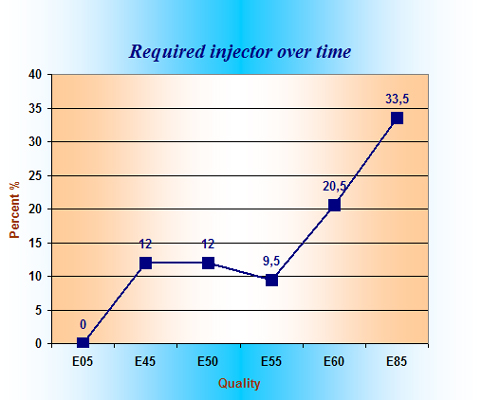
A guide for fuel mixing people which helps when it's time to fill up:
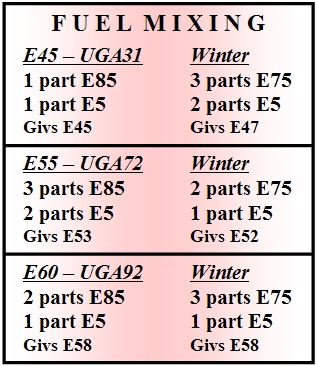
Instructions for the methodology when refueling LFG-fuels:
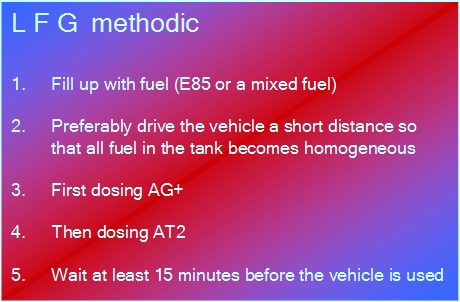
Formula to adjust AG+ (E?? is less or equal to 85)
Amount acetone = (85 - E??) x 0.0035 x amount AG+
AG+ should be dosed accurately. The method one should use may then differ depending on the circumstances.
Example: 40 liters of mixed fuel E68 will be refueled in a car. The available fuels are E85 of winter quality, ie 75% ethanol (25% gasoline), and V-Power with 5% ethanol content...
According to the program for calculation of mixed fuels gets: amount E85 = 90%, which is 0.9 x 40 = 36 liters, and amount V-Power = 10%, which is 0.1 x 40 = 4 liters. Then, start to fill up 36 liters of E85 and then 4 liters V-Power. Drive away about a mile and park the car. Dose 200ml AG+ (which is adjusted to E68*) and dosing thereafter AT2 promptly. Since V-Power was a part of the refueling one should use AT2 without V-Power (only T66 and acetone) - which then shall be dosed with 1%! Dose then 400 ml AT2. Now let it react for at least 15 minutes before the car is used. Do NOT wash down the additives with - for example: methylated spirits or E85.
* Lets say that you own 500 ml crude AG+ which will be adjusted from 85 to 68 - then shall 30 ml acetone be added
Amount acetone = (85 - E??) x 0.0035 x amount AG+
AG+ should be dosed accurately. The method one should use may then differ depending on the circumstances.
Example: 40 liters of mixed fuel E68 will be refueled in a car. The available fuels are E85 of winter quality, ie 75% ethanol (25% gasoline), and V-Power with 5% ethanol content...
According to the program for calculation of mixed fuels gets: amount E85 = 90%, which is 0.9 x 40 = 36 liters, and amount V-Power = 10%, which is 0.1 x 40 = 4 liters. Then, start to fill up 36 liters of E85 and then 4 liters V-Power. Drive away about a mile and park the car. Dose 200ml AG+ (which is adjusted to E68*) and dosing thereafter AT2 promptly. Since V-Power was a part of the refueling one should use AT2 without V-Power (only T66 and acetone) - which then shall be dosed with 1%! Dose then 400 ml AT2. Now let it react for at least 15 minutes before the car is used. Do NOT wash down the additives with - for example: methylated spirits or E85.
* Lets say that you own 500 ml crude AG+ which will be adjusted from 85 to 68 - then shall 30 ml acetone be added
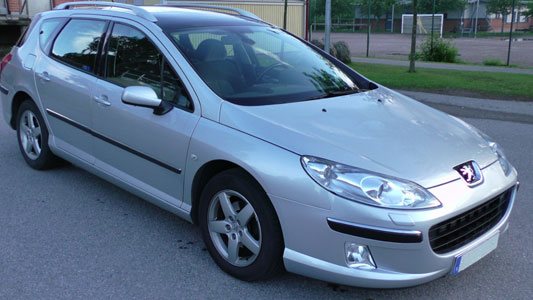
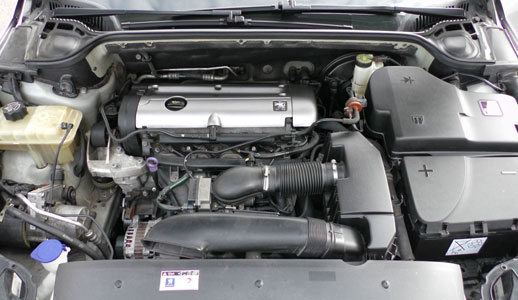

If you add 11 years to ”measure car one”, you will get measure car two - an ordinary station wagon of the brand Peugeot 407 SW from 2006. It is quite a significant modification in comparison with a 95th Xantia, if one ignoring the gas hydraulic brake, suspension and steering wheel system. Brake and the steering servo are however two separate systems in the Peugeot. There are also AC, cruise control, a lot of electronic features and electronic fuel injection of sequential type SFI (ie no direct injection), plus two lambda probes - one before and one after the cat. Thus, a turbo loose petrol powered two liter water cooled eight valve engine, still with a manual box.
Since much has happened from an electronic point of view between 1995 and 2006, no external pulse extender is required (if one fills the tank with a low-energy fuel). Adaptation takes place quickly when switching directly from gasoline to E85 or vice versa. One can claim that the car already is ethanol-adapted, even though it is designed to be powered by gasoline.
The car's ECU is very sensitive to external impact. I connected an IPE-GS with three SQ modules for each cylinder and it worked perfectly. After a while however, the computer says: stop, something is wrong! The error message: Depollution System Faulty turned out. The ECU detects that something else draws the injectors to earth potential, and this also results in an error code. A traditional pulse extender must first be masked before it can be used. One can not even solder a free hanging cord connected to the first lambda probe without ”depollution system faulty” appearing. Thinking it will be difficult to connect an LMD in the future (if at all it does any good). With pure E85 in the tank is the engine extremely hard to start when it's cold and it does not matter what temperature it is outdoors. I tried with a modified CSD and it works fine. How this CSD behaves when the winter is nearing remains to be seen. A CSD is all that is needed and the only one of my circuits that should be used for a Peugeot 407 - then you knows.
As electronics constantly getting smaller and smaller, it becomes harder and harder to make modifications of this kind. Just solder pins from all injectors to IPE-GS and SQM was a real fiddle job - on the other hand, the board seemed even more durable and robust than before.
If one choose to drive with E85 for an extended period of time should nothing special happens more than the oil gets polluted by water? I have not changed fuel filters but maybe I should - now when I suddenly starting driving with E85 - now when the miles approaching 87,000? Unless the price of E85 drops, I do not see any reason to continue with E85 but then I choose E40 instead, which I think is pretty good considering the soothing properties of gasoline. Likewise, the deposit from gasoline is also nice to get ride of. Any profit or loss can not be determined regardless of the gasoline/E85 blend ratio, it will be the same cost anyway - I've checked! At least, that is the case with the prevailing fuel prices 2017... Water separation and turbo charging with a computer fan may be a later project?
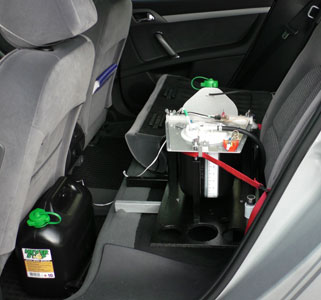
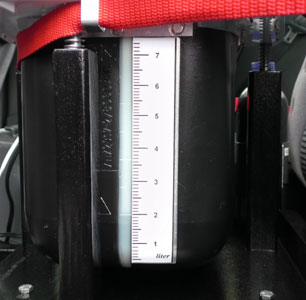
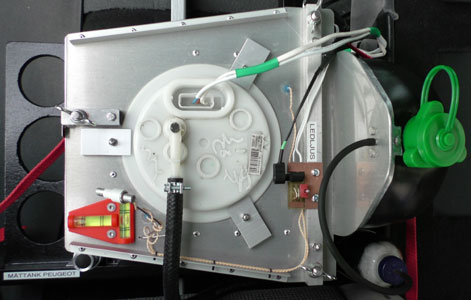
This time, I chose to build a significantly better construction that is located in the rear seat quite close to the normal fuel pump's residence. Here we talk about a permanently mounted external tank (ET) with its own fuel pump (purchased on the scrap yard) which is of course, identical to the regular pump which remains completely inoperative during the measurement periods. An extra extension hose from the regular pump to ET is required as well as extension cables to the electrical connections. ET consists of a 10 liter (2.64 gal) carved fuel can (same as it next to it) and an aluminum plate to hold the pump in place. The entire tank unit rests on three spring loaded suspension points on a black lacquered wood structure. ET is therefore adjustable in the horizontal plane with three wing nuts.
Before and after a reading of the amount of fuel one must first check the position of ET using the water pass. If one forgets that - one will get a rough error reading. This has not happened so far even though the picture shows that the tank unit is wrong-weighted at the time of the photo. The red belt is a safety feature to avoid being hit by this device (filled with fuel) in case of a crash. Everything is a unit that easily can be mounted/disassembled when the need calls? Since the fuel system of the car not has any return line, one must bleed the fuel lines (it's done at the engine) every time a shift with or without ET occurs.
The system is constantly vented so that no pressure increase can occur in the external tank. The silicone seal between the plastic and the aluminum can not withstand any overpressure. Silicone adhesive is by far the only sealant that works in this environment. The ventilation goes to a carbon filter, a Vitamin Well bottle filled with activated charcoal (no bad odor releases). Someone may wonder if I can read the fuel meter on the instrument panel? It is indeed connected but is completely unreliable. The pointer is mostly located in the middle of the scale, but gives a little hint about what is present in ET. In fact, one can completely empty ET with the siphon principle and then refill with another fuel without to having bleed the fuel system, it's smooth.
The left image gives the impression of a clean and stylish environment. During test runs however, the situation is quite different: on the floor there is usually a lot of cans, bottles and hoses in a blissful mess. The pictures were taken in March 2017 but later the green screw cap was replaced with a rubber stopper for chemical bottles. Quite a lot of hours have been completed until this writing (June 2017) without anything else in the design has changed. On the front one can see holes for three bottles of different dimensions and a hole for a graduated cylinder.
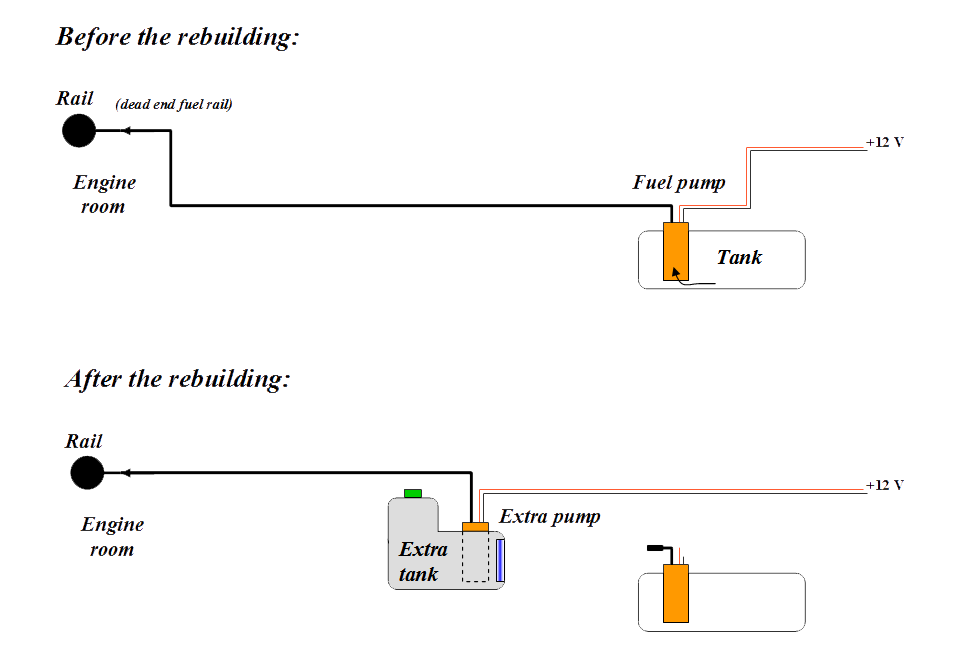
Of course should all fuel consumption measurements be done in the same way: same route, same equipment except the fuel, as understood. When something is to be register and published later, a proper test must be done in the same manner as all other tests were made, as far as possible.
However, to getting a hum if anything means a difference in fuel consumption, can one do a fast test. This means that one aimlessly driving around with an ET. At any arbitrary starting point takes the fuel level and resets the distance meter - then one drive to some ending point. Then the amount of fuel can be estimated and the consumption can be calculated by the information of the cars distance meter.
It is impossible to dash in the correct temperature, atmospheric air pressure, winds or other weather/season controlled parameters every time, but what can be controlled should be controlled, likes the car's weight and tire pressure, as well as avoid changes (change of oil, filter, spark plugs etc). It is not that smart for example to switch to a new air filter during an ongoing measurement period. A change from winter tires to summer tires was made in March but no major impact could be found. Tire pressure, temperature, wind, high pressure / low pressure, oil wear, etc - consider someone out there - having a meaning - if my measurement results shall have a value - but then it should be remembered that there is no point in specifying the fuel consumption for any vehicle if that were the case. For example, I do not drive with a cold engine or if it is blowing or raining. My own experience says that the aforementioned variations not are significant, but outside temperature, atmospheric pressure prevailing weather conditions are still recorded for those who are curious.
Now in 2017, it's time to make new measurements with another car model - a Peugeot 407 SW. The point of driving in city traffic has lost its significance, as I now think it is sufficient for highway driving because: if there are differences in fuel type - it will be most apparent then. Driving in city traffic is uncertain, where a number of situations can lead to difficult-to-understand results.
- In the samples should I also assign the prevailing atmospheric pressure in mill bars.
- The ring (tire) pressure should be controlled so that it always remains constant.
- Cruise control is used almost all the time as the speed varies between 70 and 80 km/h (most 80 km/h).
- Timing is not done because nothing can happen that affects time.
- The speed limits on the road are followed very accurately by the cruise control.
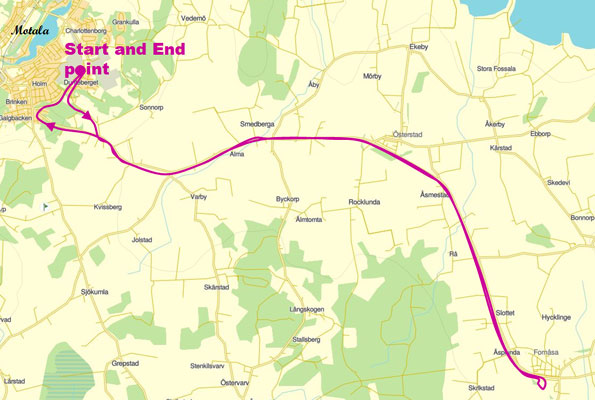
MEASUREMENTS RESULTS:
Common to all tests:
Normal driving, no hard braking or acceleration.
No load in/on-loaded and that there is only one person (the driver) in the car.
The lambda is always one or near one.
The outdoor temperature is in Celsius. 20 Celsius is 68 Fahrenheit or 293 Kelvin.
15 Celsius is 59 Fahrenheit or 288 Kelvin.
In Sweden we normally use liters per mils (10 km). 1 liter per mil is 23.5 miles per gallon (US).
| No. | Date | Fuel | Ingredient | Driver- condition |
E.c. (µS/cm) | Temp. outdoor |
Average- consumption |
Gain | Other / remarks |
| 28 | 170310-170318 | E5 (95RON) |
FeTA | clear / 1020 |
- | 4 C | 36.2 mpg |
0% | The temperature
ranged between -3 and 8 C. It was high pressure weather all the time. Both winter
and summer tires were used. |
The first run for several years is an average of total eight runs with FeTA, which shows that this type of fuel additive for plain lead free 95 (RON) does not affect the fuel consumption at all. When I had estimated that FeTA reduced fuel consumption in the past 2015-16, I used the instrument panel fuel meter and filled 10 liters in a round. It went well because my fuel indicator is of the accurate variety. The mistake I made was not to measuring what untouched gasoline had for figures first, before the measurements with the FeTA additives commenced. My memory tells me I did not. That the petrol out in trade suddenly got better between the runs I did 2015-16 and those with the measure car in March 2017 are less likely. Then it becomes a problem when one rarely has an absolute additive but rather a mixture of several. With a measuring car is that problem out of the world.
| No. | Date | Fuel | Ingredient | Driver- condition |
E.c. (µS/cm) | Temp. outdoor |
Average- consumption |
Gain | Other / remarks |
| 29 | 2017-05-12 | E5 |
- | clear / 1010 |
- | 8 C | 36.2 mpg |
0% | Several hundred
miles were driven with plain lead-free 95 (RON) before these measurements were taken.
Summer tires were used. |
A total of two measurements were made the same day showing that the fuel to which the car is to be operated (according to the instructions) also leading to consumption figures that is hard to beat.
| No. | Date | Fuel | Ingredient | Driver- condition |
E.c. (µS/cm) | Temp. outdoor |
Consumption | Gain | Other / remarks |
| 30 | 2017-05-19 | E85 (St1) |
- | party cloudy / 1010 |
1.2 | 24 C | 27.4 mpg | 0% | This particular E85
apparently had quite high conductivity. |
| 31 | 2017-05-19 | E85 (CK) |
- | party cloudy / 1010 |
0.2 | 20 C | 28.0 mpg | +2.3% | Circle K also supplies
the petrol product miles Plus 98, which is very well comparable to V-Power. |
| 32 | 2017-06-06 | E37 |
60% 95RON & 40% E85 |
party cloudy / 1000 |
- | 14 C | 33.1 mpg | -9.2% | Fuel mixing can be
done as well. Typical data for two existing fuel products. |
The first E85 test from St1 can be seen as a good target value for later tests. Consequently, the consumption of ordinary E85 is 32% greater than the vehicle's correct fuel. With E85 from Circle K, consumption decreases slightly (giving a 29% increase instead) because the ethanol contains anti-friction inhibitors.
My additive T66 seems to have the same effect on cheap ethanol as Circle K has on the consumption with theirs own ethanol. See results for sample 37!
Sample 32 shows that the consumption of E37 is as expected, either Bu or bee.
| No. | Date | Fuel | Ingredient | Driver- condition |
E.c. (µS/cm) | Temp. outdoor |
Consumption | Gain | Other / remarks |
| 33 | 2017-06-08 | E85 (own) |
- | party cloudy / 1000 |
3 | 16 C | 23.5 mpg | -16.3% | Self-made E85 by
Carwise Red Ethanol and Biltema Alkylatbensin 4-T, as I drove in the car
properly before the samples started. |
If you do not want to use E85 from the gas station you can do it yourself. The tours around today's E85 and NAMAG were previously discussed in the The News Bulletin. What I'm looking for here or want to be confirmed is to see if NAMAG has any effect on E85, as I said earlier. The suspicions had been directed at the oil companies, which I considered spiced E85 with IBA, which meant that my acetone and glycol additives no longer worked. When I heard of FoHMFS in the summer of 2015, it came to my attention that my mind was correct. In 2011, the new regulations introduced that 0.5% IBA should be dosed in all E85. If now this is the answer to why the effects of many of my additives suddenly ended can I not prove but something has to happen and since no reasonable explanation is yet available, that's the 2011 rules that apply until further notice.
Now it's not as easy as I seem to implying: that all E85 is bad, but one can instead see it as: today's E85 has everything one need to get it work optimally - if one ignore a splash of T66...
Sample 33 reveals that the consumption was abnormally high for this home-made variant - why I do not know. But in comparison with gasoline it is a 54% increase in consumption! Had the consumption of gasoline been around 30.9 so would it be normal with a decrease of 23.5 miles per gallon for pure E85 - but that's not the case. What's a bit awkward is that with NAMAG my home-made E85 was transformed into something more similar to normal E85, which the next test showing.
| No. | Date | Fuel | Ingredient | Driver- condition |
E.c. (µS/cm) | Temp. outdoor |
Consumption | Gain | Other / remarks |
| 34 | 2017-06-08 | E85 (own) |
NAMAG | clear / 1000 |
13 | 12 C | 26.7 mpg | -2.3% | Home-made E85
and NAMAG show positive effects. |
| 35 | 2017-06-10 | E85 (St1) |
NAMAG | party cloudy / 1010 |
- | 18 C | 27.4 mpg | 0% | Apparently, I forgot
to measure the conductivity for this test. |
| 36 | 2017-06-12 | E85 (Preem) |
NAMAG | shower of rain / 990 |
11 | 13 C | 26.7 mpg | -2.3% | E85 from Preem
makes no difference. NAMAG does not work here either. |
This confirms that NAMAG has positive effects on (home-made) E85
If that was what happened when I driving around with my Citroën Xantia in 2013 - filled 10 liters and drove until the fuel ran empty of the tank - that I can not say but the easiest explanation is, that there will be some impact with NAMAG but not so big like what happened in 2013. The fact that I drive such far during a test cycle in the autumn of 2013 was certainly due to: it was fuel left (hidden in pockets) from previous fillings. Three times I got incredibly low consumption figures, which not has been replicated later.
26.7 according to test 34 applies if one not refers the real fuel volume, where the ethanol part occupies 96% of the methylated spirit and the rest is water. If one do that, thus counting off the water from the total volume of ethanol, alkylate petrol and water consumed during the test run, so then one get a lower consumption figure. This is 27.7 which means a profit (+1.2%).
The yield from 23.5 mpg up to 26.7 mpg is +13.6%, which is not bad at all - only with a fuel additive. NAMAG is quite complicated additives that to be dosed 2.5%. Most likely, there are already simpler and cheaper methods to accomplish what I have accomplished here.
| No. | Date | Fuel | Ingredient | Driver- condition |
E.c. (µS/cm) | Temp. outdoor |
Consumption | Gain | Other / remarks |
| 37 | 2017-06-12 | E85 (St1) |
T66 | party cloudy / 990 |
3 | 15 C | 28.0 mpg | +2.3% | If this is true, only
a little T66 is required for boosting E85? Small remains of NAMAG were left in ET when
this test was done! |
Lighter fluid purchased from Rusta and little stored city diesel was used to blend an old honorable T66, which seems to affect today's highly efficient commercial fuels...
In September 2017 started the second test series with my Peugeot, because in the summer I built two new devices - a speed-controlled computer fan at the inlet and a shield / sheet on the car's air intake at the front (grill). The fan eliminates the resistance that the air transport entails until the air filter. It is positioned directly below the air filter and creates a small pressure against it. Because the regular transport path now is sealed and blocked so is it okay to also block the grill without risking the engine getting too little air (as the air now is taken from the left side of the engine with a fan). These devices have a symbiotic relationship to each other. Thus, the air shield at the front can not exist without first resolving the way in which the need of air shall be met.
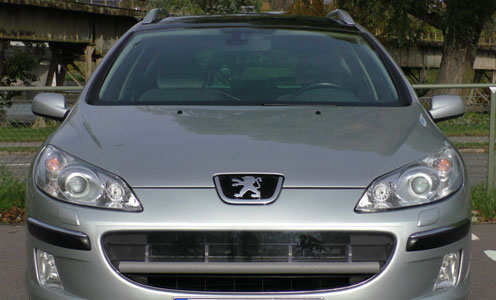
It's about air resistance! This gap that can be found on most fossil cars is enough to feed a smaller jet engine. The reason is that the cooling demand must be enough even if driving on an uphill in Sahara (dragging a caravan). This scenario rarely occurs in my country and therefore it should be possible to reduce the hole / gap without causing any problem. I've been driving with it at 30 degrees Celsius (86F) without tendency of rising engine temperatures. The material is a sheet of polycarbonate that is stuck with four screws and two tie straps and can be difficult to distinguish from the image above. If you own a turbo, this principle does not apply because an intercooler must have a lot of cooling air.
Stockholm, June 2021: Ever since this was written, I have had the shield mounted on the car. I drove from
Gustavsberg and was going to Hasselby. When I approached Hasselby I got a warning about low battery voltage, a few seconds later the engine stopped and the car
was basically dead. It turned out that the generator does not deliver power after a quick check of the battery voltage. Both battery and generator could be
replaced on-site and everything was finished and ready to go the same day - however, I became 1000 bucks poorer. It should be mentioned that this day (a Friday)
I had great luck because the car chose to stop in a low-traffic place, a downhill with seven-day parking at the end. In addition, I got help almost immediately
from Zebbe who drove me to buy a new car battery (he had had a similar car), and Peter who turned out to work as a repairman at Peugeot (had done work on that
model). The fact that Peter showed up almost at the same time as my car got broken, I still think is strange... Peter took care of my problem without hesitation
(for a promised payment), called, pondered, and found a generator at Mekonomen in Sollentuna (his mother worked at Biltema). I took the tube to Sollentuna,
bought the generator, came back, Peter started the change of parts and everything went back to normal.
During this visit to the capital, it was the Swedish summer climate that prevailed. It was sunny and quite warm. When I touch the new generator after a test drive, I could feel that it was hot, hotter than the engine actually. The shield stopped almost all cooling air from entering the engine compartment and for that reason, the radiator fan went to max all the time. My radiator fan is of the quiet sort and is difficult to notice if you do not bend down in front of the grill, then you will hear it. What is also not noticeable is the copious amounts of electricity that the fan consumes when it has to work almost constantly. That was probably what killed the generator, I guess? The shield was dismantled almost immediately and has since been placed in attic storage. It is actually stated in the instruction manual that the owner should mount some form of protection device into the grill at wintertime, so that snow does not clog the radiator... In addition, one can read that this protection must be removed if the temperature exceeds 10 degrees Celsius! So that's when my shield can start to work again, when the outdoor temperature has dropped below 10 degrees - at least!
During this visit to the capital, it was the Swedish summer climate that prevailed. It was sunny and quite warm. When I touch the new generator after a test drive, I could feel that it was hot, hotter than the engine actually. The shield stopped almost all cooling air from entering the engine compartment and for that reason, the radiator fan went to max all the time. My radiator fan is of the quiet sort and is difficult to notice if you do not bend down in front of the grill, then you will hear it. What is also not noticeable is the copious amounts of electricity that the fan consumes when it has to work almost constantly. That was probably what killed the generator, I guess? The shield was dismantled almost immediately and has since been placed in attic storage. It is actually stated in the instruction manual that the owner should mount some form of protection device into the grill at wintertime, so that snow does not clog the radiator... In addition, one can read that this protection must be removed if the temperature exceeds 10 degrees Celsius! So that's when my shield can start to work again, when the outdoor temperature has dropped below 10 degrees - at least!
What matters the fan, it exceeded my hopes. The car is definitely more alert and it's probably no exaggeration if I claim I've got between five to ten horses extra? This with a computer fan which most consumes 5 watts! It is a Cooler Master - Jetflow 120 with 95 CFM which has unmatched high airflow. This fan is also manufactured in China but does not have the performance as the original. The model (original): R4-JFDP-20PW-R1. This primitive construction, which is comparable to an electric compressor, causes the fuel consumption to increase 5%. Fortunately, the air shielding decreases consumption by 5% - therefore the both devices compensate each other. That means: more horses but with retained fuel consumption (at highway driving).

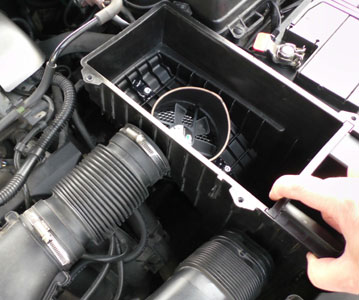
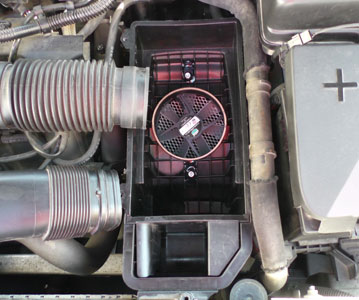
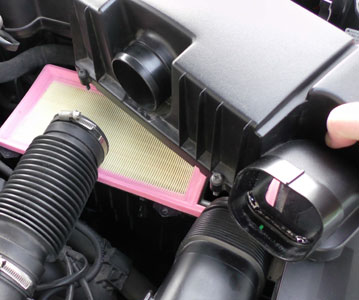
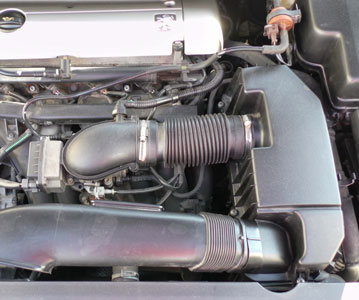
The speed is controlled by the ”opening time” of the fuel injectors and requires therefore something that can measure it (IPM10) as well as a PWM circuit. The driver circuit becomes a simple story because the power requirement is small (max 5W). Thus, the speed increases at higher engine load and decreases or stops completely at, for example: engine braking. At idle speed: the fan spins slowly. The fan is illuminated with LEDs, which also illuminate more bright depending on the speed. In the pictures one can see a grid but it can be removed if the fan is facing downwards, which is the case for me. Once everything is in place one can hardly detect the device. No visible modifications can be seen more than the air shield on the grill. The construction does not cause any difficulties since most can be mounted with hot melt adhesive.
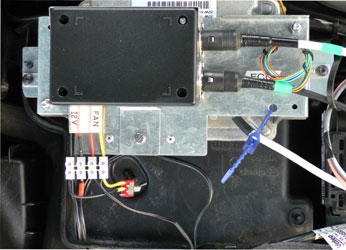
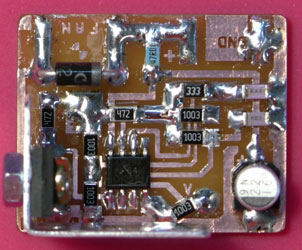
The PWM circuit can be found in the IPM10 documents and has been dubbed FC10. It's a fairly simple structure that however fulfills its task. One has to keep in mind that computer fans not are designed for 14 but for 12 volts! Then the question is what happens when it is exposed to low temperatures and high humidity? With one, two or three diodes in series with the fan, the voltage can be reduced. I took the power from the dipped beam to supply the fan.
The main purpose of this measurement is to determine the right fuel consumption the shield and the fan has? Even though the IPM10 circuit was in use I chose not to show the opening time. My current car has a completely different dynamic than the previous one and just the opening time at idle is difficult to interpret as it can vary in an irreversible way. The last test gave me some kind of knowledge when I mixed i¤b (iron benzoate) in E85.
In general, this measurement complies with Test Series 2-1, in addition to the two above mentioned accessories as well as with quite new engine oil and new air filter. Round-trip: Motala Fornasa.
MEASUREMENTS RESULTS:
Common to all tests:
Normal driving, no hard braking or acceleration.
No load in/on-loaded and that there is only one person (the driver) in the car.
The lambda is always one or near one.
The outdoor temperature is in Celsius. 20 Celsius is 68 Fahrenheit or 293 Kelvin.
15 Celsius is 59 Fahrenheit or 288 Kelvin.
In Sweden we normally use liters per mils (10 km). 1 liter per mil is 23.5 miles per gallon (US).
| No. | Date | Fuel | Ingredient | Driver- condition |
E.c. (µS/cm) | Temp. outdoor |
Consumption | Gain | Other / remarks |
| 38 | 2017-09-10 | E37 (Shell) |
T66 | clear / 990 |
0.1 | 12 C | 33.1 mpg | -9.2% | Both air shield and fan
were used here. The engine oil was very fresh here like the air filter that was almost
completely new. |
In order to see where the consumption lands, I chose to drive with same fuel as I recently has used before this tests. The first attempt shows that the fuel consumption was normal and also identical to sample 32 - except for the use of T66. Does one take into account that the oil just has been replaced, the air filter is new and that fuel additive T66 is dosed so would one expect the fuel consumption had been a little lower? The reason is probably the fan arrangement.
| No. | Date | Fuel | Ingredient | Driver- condition |
E.c. (µS/cm) | Temp. outdoor |
Consumption | Gain | Other / remarks |
| 39 | 2017-09-11 | E37 (Shell) |
T66 | party cloudy / 990 |
0.1 | 16 C | 32.2 mpg | -12.3% | Here only the fan was
used - the air shield was removed! |
When the shield was removed increased also the consumption. This because of the fan device.
| No. | Date | Fuel | Ingredient | Driver- condition |
E.c. (µS/cm) | Temp. outdoor |
Consumption | Gain | Other / remarks |
| 40 | 2017-09-11 | E37&Water |
T66 | shower of rain / 990 |
0.3 | 17 C | 32.2 mpg | -12.3% | 1% water in the E37
fuel and T66. Both air shield and fan here. |
A. Tuttle in Texas contacted me in April and wondered if I did any experiment with water in gasoline? AT owns, among others: a Honda Civic LX 92 and a Ford Taurus SE 05. The use of pure gasoline causes lot of soot in the engine, which in the long run interferes with its function (this is an even bigger problem for today's direct injection engines). I am familiar with this reasoning and my suggestion was to try E85?
Now it is so that AT lives in the outback and therefore not has access to E85. Although Texas is famous for its oil deposits and has extensive activities that can be related to various motor fuels, it is quite badly with the quality and supply. The only sure is to drive on gasoline - E85 is not to be trusted. AT have done many tests with IPA in gasoline to be able to add water and apparently it worked with a composition comprised of: IPA (iso-HEET), water and lube oil (Marvel Mystery Oil). By using keyhole technique and filming the actual combustion chamber through the spark plug hole, it was possible to purely visually observe that the soot decreased. My contribution or proposal was to start with E15 and add 0.5% water and a little D66. My relationships with IPA are quite strained nowadays and putting this alcohol in my range again seems unrealistic, I'm afraid. Recently has the method of water in the fuel become a very interesting side track, which I will describe in detail later...
| No. | Date | Fuel | Ingredient | Driver- condition |
E.c. (µS/cm) | Temp. outdoor |
Consumption | Gain | Other / remarks |
| 41 | 2017-09-12 | 95RON |
- | party cloudy / 990 |
0 | 13 C | 36.8 mpg | +1.5% | Test with common
lead free gas here and with air shield and fan. |
Here the consumption shows good figures when driving with the vehicle's correct fuel (without additives) along with this air shield and fan history. It's okay?
| No. | Date | Fuel | Ingredient | Driver- condition |
E.c. (µS/cm) | Temp. outdoor |
Consumption | Gain | Other / remarks |
| 42 | 2017-09-13 | E85 |
T66 & i¤b | clear / 980 |
3 | 16 C | 28.0 mpg | +2.3% | Test with iron
benzoate in E85 and with air shield and fan. |
Apparently is there an absence of improvements with only iron benzoate in an ethanol fuel - as the test 42 tells us. I¤b is supposed to act as a catalyst for possibly hexamine and then one can not expect a positive result at this stage.
In the early spring of 2021, I decided to get to the bottom of the NAMAG mystery, which may have caused this low fuel consumption, which I got during some test rides in 2013. In principle, I was constantly engaged in this throughout 2021 and until the spring of 2022, for about a year and a half.
I tested many constellations. What worked best was G+ that I had saved since 2010, when Biltema (Swedish trade) sold red G30 glycol with N-EHN (G12), which later disappeared from the shelves. What I eventually came to the conclusion was partly that the old glycol plays a big role, and partly that you should dose the right amount of T66. 0.5% T66 in E85 is a bit too much. T66 or the even better constellation T50 should be dosed more the more ethanol the fuel contains. This follows a non-linear graph. Ordinary gas (E10) requires only a little T50 while E100 requires about 0.5%. After many test runs where I adjusted the amounts of all components depending on ethanol content, such as glycol, HMTA, water, and T50, I was finally able to create a mathematical algorithm. This took its time because there are a lot of combinations - because you want to avoid guessing - guesses can be risky because reality often carries insidious truths... In the end, my efforts were hampered due to the fact that it was difficult to get positive consumption figures - it was easier in the beginning. The reason is probably due to the fact that the commercial fuel E85 has recently undergone modernization. This was confirmed to me when I carried out the consumption tests with my measuring car, during the early summer of 2022.
When I first performed the consumption tests with pure E85 (to determine if untouched E85 is the same as before), I noticed that these were totally superior to all previous tests, as well as what my fuel additives have ever been able to show. For example, Qstar with its E86 which was over 30 mpg. It is far better than what I have achieved - if we ignore the individual tests in 2013... This is what it looks like in 2022, in principle every gas station (in Sweden) today sells E85 of this high quality. The question you can ask yourself is: will it remain so in the future as well? How can this be? You can see that I was run over at the goal line, just when I started to finish my work, the conditions changed dramatically. But now you do not need additives and it is the best thing that could happen, that the fuel companies have finally realized the benefits of small quantities of cheap components. I'm not so naive as to think that only I have knowledge about this. Of course, these giant companies conduct their own research in their own laboratories, around the world. For them, ethylene glycol, HMTA, and various naphtha additives are an old story, right?
The layout for this test series is identical to the one implemented in 2017 - the same car, and the same equipment. Despite the fact that the car has rolled several miles since it left last time, the consumption figures are lower.
MEASUREMENTS RESULTS:
Common to all tests:
Normal driving, no hard braking or acceleration.
No load in/on-loaded and that there is only one person (the driver) in the car.
The lambda is always one or near one.
The outdoor temperature is in Celsius. 20 Celsius is 68 Fahrenheit or 293 Kelvin.
15 Celsius is 59 Fahrenheit or 288 Kelvin.
In Sweden we normally use liters per mils (10 km). 1 liter per mil is 23.5 miles per gallon (US).
| No. | Date | Fuel | Ingredient | Driver- condition |
E.c. (µS/cm) | Temp. outdoor |
Consumption | Gain | Other / remarks |
| 43 | 2022-06-02 | E85 (Circle K) |
- | clear / 1010 |
0.5 | 15 C | 29.4 mpg | +7% | Previously, Circle K's E85 contained secret additives,
but I do not think that applies anymore. 27.4 mpg is normal, so something has happened... |
| 44 | 2022-06-05 | E86 (Qstar) |
- | clear / 1020 |
0.3 | 21 C | 30.2 mpg | +10% | Six degrees warmer outside, which may explain why
consumption dropped another notch? |
| 45 | 2022-06-09 | E77 (Preem) |
- | clear / 1000 |
0.5 | 19 C | 30.2 mpg | +7% | Here it gets a little complicated because Preem
runs on winter ethanol in June. Preems E85 may not be modified yet? |
| 46 | 2022-06-10 | E75 (Shell) |
- | clear / 1010 |
0.4 | 15 C | 30.2 mpg | +7% | Same thing here. Shell in Motala is even worse
than Preem. Hard to say if Shells E85 is modified. |
So far, I can not say whether this “modernization” of E85 applies everywhere in Sweden because of the winter ethanol. Maybe I'll have time for more test rides later this fall? These should then dispel the ambiguities surrounding this. It has been shown that the lubricity in the E85 that Circle K and Qstar market seems deficient, so it may be a good idea to add D66, T66 or AT in the now “modernized” E85.
As it has been criticism about this with acetone and glycol as power-enhancing ingredients in gasoline and E85, I had to do a new survey. What has emerged is that the reduction in opening time depends on the viscosity of the fuel has fallen, not to fuel emits more energy due to surface tension reduction or that the spread of the fuel becomes more efficient. This explanation was of such great materiality that sooner or later should someone examine whether the viscosity become smaller under the influence of acetone or glycol. Reduces the viscosity can the fuel injectors inject the same amount of fuel but with shorter opening time and that is precisely what is happening here. The opening time is shorter than if you drive without acetone or glycol - as I self have been able to see.
I chose to use two pet bottles during the experiment and the whole thing looked like an hourglass, so it may be known as the hourglass-method here. One pet bottle has a narrow hose stump that is secured through a hole in the screw cap. This hose stump shall the fuel run through and clock it with a stopwatch. In this pet bottle other end (the bottom) is an air hole (7 mm). The time it takes for a full bottle to be empty, is close to 10 minutes. I therefore need to hold the bottle still for about ten minutes. In total were 15 draining, spread over five different samples with three tests for each sample. Imagine for example that we would have syrup in the bottle - then it would take a very long time. Thus - the shorter time it is, the lower is viscosity.
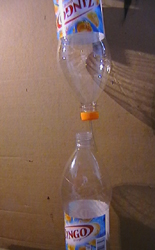
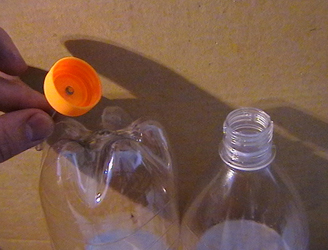
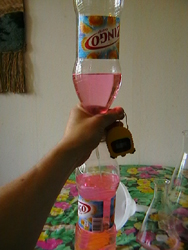
Only E85 |
E85 with acetone by the formula: A = E85 x 0,00035 |
E85 with glycol by the formula: A = E85 x 0,005 |
E85 with acetone by the formula: A = E85 x 0,0023 |
E85 with G14a |
9:30 minutes |
9:46 minutes |
9:52 minutes |
9:35 minutes |
9:42 minutes |
9:33 minutes |
9:40 minutes |
9:41 minutes |
9:39 minutes |
9:40 minutes |
9:33 minutes |
9:43 minutes |
9:39 minutes |
9:54 minutes |
9:44 minutes |
This test series shows that pure E85 have the lowest viscosity in comparison with all other variants, which has higher viscosity. The conclusion is then that there is no change in viscosity who thus resulting in a smaller opening time. However, as this test has not taken account of elder batches and viscosity changes when the liquid is pressurized for one or more bar.
As if this were not enough, I have also heard a rumor that the viscosity of E85 varies widely with temperature. This is something that I myself did not believe in, because my feeling says that alcohol like water have a relatively constant viscosity, but to be on the safe side so prepared a further series of tests, which hopefully will give some light about the issue of E85 and its viscosity at different temperatures. The temperature was measured at three different times for each test.
no. |
Type |
Average temperature [Fahrenheit] |
Time |
1 |
room temp. |
72 |
7:18 minutes |
2 |
room temp. |
72 |
7:22 minutes |
3 |
heat |
126 |
7:25 minutes |
4 |
heat |
131 |
7:36 minutes |
5 |
cooling |
50 |
7:53 minutes |
6 |
cooling |
45 |
8:34 minutes |
7 |
cooling |
37 |
8:30 minutes |
8 |
room temp. |
72 |
8:09 minutes |
9 |
heat |
109 |
7:56 minutes |
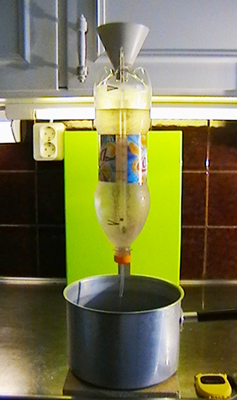 The picture shows an emptying of cold-E85. The markings for the timing is clearly visible.
The picture shows an emptying of cold-E85. The markings for the timing is clearly visible.Here appears my assumption to be correct and the tests did not show any kind of continuity - rather it jumping all time in a completely non-predetermined manner. The shortest time was no. 1 (72 degrees) and the maximum no. 6 (45 degrees). However, there are suggestions that the viscosity decreases slightly when it gets colder, but it is very marginal.
|
| |
|
| |



